
Director’s Welcome
When you picked up this latest edition of Discover magazine, hopefully you noticed it is a little heftier than in the past. That’s because we’ve added lots of new content with more featured articles, highlights from our collections, and updates about the museum.
In this edition we continue to explore a theme of “Hidden History” and shine a light on several forgotten or lesser known aspects of Golden history. We examine the explosive and controversial Coors labor strikes of 1957 and 1977 that deeply divided the Golden community. We explore the history and legacy of redlining practices in Golden and Jefferson County that prevented non-white owners from purchasing property in the region. And we shed light on the work and legacy of Vine Deloria Jr., author, theologian, and one of the most notable Native
Staff
American activists of the 20th century. We also observe the anniversary of the COVID-19 pandemic, the losses it has wrought on our communities, loved ones, economy, and psyche. But, we also look forward with hope and optimism in 2021 as vaccines are distributed and we emerge from our shells. We look forward to presenting more programs in hybrid virtual and in-person formats as well as reintroducing events and public gatherings as health and safety permit. Thank you as always for your incredible support of Golden History Museum & Park! I look forward to seeing you here soon.

DISCOVER I SPRING
IN THIS ISSUE
Hands-On History
Union-Free
Union Trivia
Brewery Strike of 1977 Programs
A Legendary Person
Race-Based Restrictions
Staff Profile

Volunteer Profile
Donors
Collection Corner
Membership Letter

Membership
Salon Art Exhibits
Nathan Richie, Director
Nathan Richie Britton Taylor
Mark Dodge Vanya Scott Director Education Assistant Curator Curatorial Assistant
Annika Firn M. Kathleen Eaton
Doug Skiba
Andrew Terrill
Student and Interpretation and Development and Graphic Design Family Programs Visitor Experience Communications and Layout Coordinator Coordinator Coordinator (Freelance)
Cover image: Joe Coors (left), Bud Peddycoart, and Bill Coors, April 25, 1957.
Photo © Golden History Museum & Park, City of Golden Collection,
2021
2 DISCOVER I SPRING 2021
Hands-on History
Hands-on History summer camp is a fun-filled weeklong day camp for kids aged 6 to 12 in the beautiful Golden History Park.
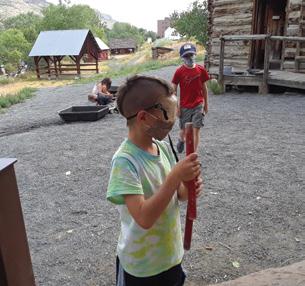
Campers will use their hands as much as their brains, whether in Dirty Jobs, Pioneer Kids, History Mystery, or Art Explorers.

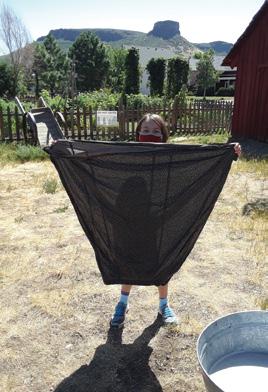


In our ever popular Silent Stars, exclusively for older campers aged 9 to 12, kids will write, direct, and star in their own silent movie.
Registration is in full swing at GoldenHistory.org/HOH Act soon to get your favorite sessions. Details about all five themes are on the website.


DISCOVER I GoldenHistory.org 3
Union-Free:
Organized Labor at the Coors Brewery
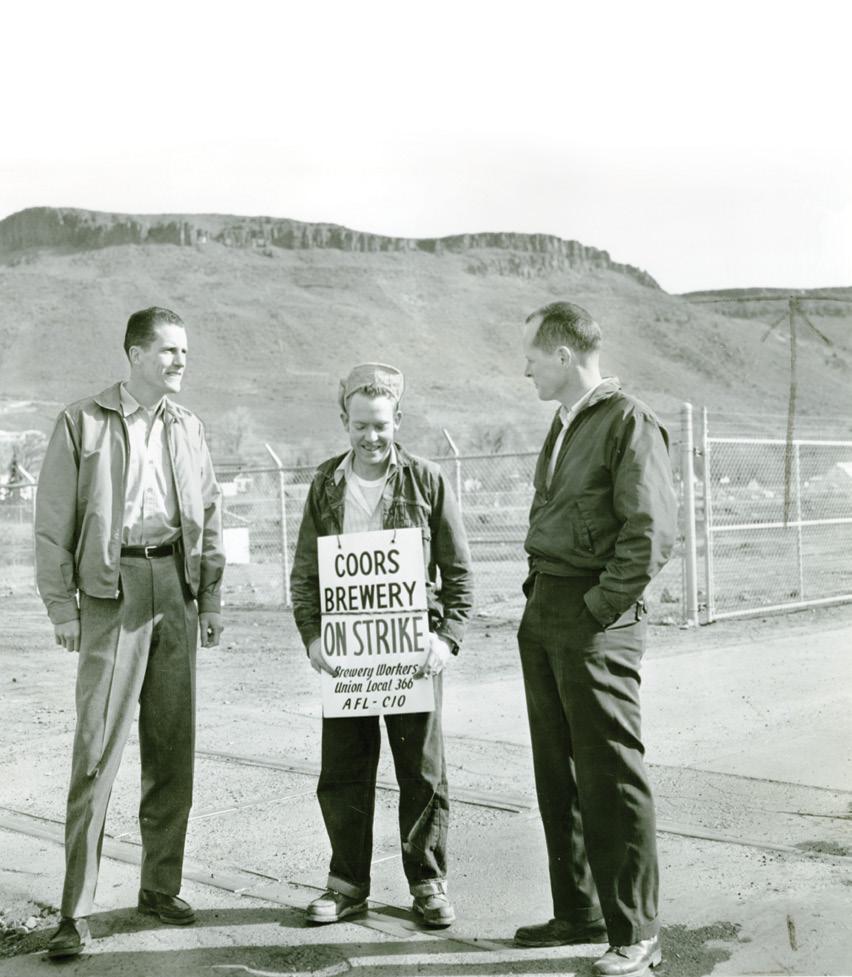 By Mark Dodge, Curator
By Mark Dodge, Curator
4 DISCOVER I SPRING
2021
Joe Coors (left), executive vice president, and Bill Coors (right), president of Adolph Coors Co., chat with picketer Bud Peddycoart of Arvada on April 25, 1957, at main gate of the Coors plant in Golden. Some 450 brewery workers struck at the brewery, closing the plant down except for a standby crew of the supervisory employees.
Photo © Golden History Museum & Park, City of Golden Collection.
Labor strife at the Coors Brewery reached its pinnacle in 1977, the year that brought an end to 100 years of organized labor at the brewery. Conflicts between workers and owners over wages and working conditions are nothing new, but the story of Coors’ labor practices and union-busting is largely forgotten outside of labor and academic circles—and those who lived it. Golden History Museum & Park is shining a light on this complicated history and laying the groundwork for future research on this lesser-known side of one of Golden’s most famous employers.
For years, the Adolph Coors Company has been both praised and vilified as paternalistic. Bill Coors, who spent over

70 years with the company until his death in 2018, would later reminisce about his relationships with employees, proudly saying he knew everyone by name. If you worked for Coors, many said, the company would take care of you for the rest of your career— an attitude held to this day among many retirees and old-timers, especially those who worked in management.
But those who vilify that philosophy might say that the attitude existed only if you worked under unfair and dehumanizing contracts, and did only what you were told. Owners and management were oppressors— an outlook that set the stage for years of conflict. Labor leaders additionally felt that
The Daily Transcript, Wednesday, April 6, 1977. Continued overleaf

‘‘ DISCOVER I GoldenHistory.org 5
I honestly see very little appropriate role for unions in this day and age.
—Joe Coors Sr., 1978
the ensuing strikes were about nothing less than human rights and basic dignity. Meanwhile, for better or worse, those seeking jobs sought work at Coors. The jobs paid well and were coveted.
A union shop from the start
While most modern accounts date the brewery’s union activity to immediately after the end of Prohibition, Bill Coors wrote in his memoir that the employees of the original Schueler and Coors Golden Brewery were represented by the International Brewery Workers Union when Adolph Coors and his partner founded the company in 1873. “Strikes and boycotts have been with Coors through the years,” he later said. One of the first (and shortest) was documented in the
local paper. It happened on September 30, 1907, beginning at 8 am and lasting until evening of the same day. Nearly 100 men and boys refused to work until foreman/ superintendent Joseph Besser was fired for gross overworking of the laborers, to the point of compromising the product.
In a 1916 union dispute, brewery manager Grover Coors said, “For years we have been harassed by the union.” Prohibition ended the production of beer in 1916, but with its lifting in 1933, Adolph Coors Jr., who personally saw no use for unions, still felt that people wouldn’t drink beer unless it was union-made—a common sentiment nationwide. So, he found ways to work with the union and compromise, an approach that prevailed until the 1950s.
A change in union leadership and management tactics
In the 1950s, local union leadership, motivated by aggressive east coast union influences, created increased dissent among workers by seeking to address new grievances. At the same time, change was in the air for management. Bill and his younger brother Joe Coors, the third generation of Coors men to steer the family business, started pushing back against union demands with the blessing of their father and older brother.

Two significant years stand out from this time: 1957 and 1977.
April 24, 1957 – Citing disagreements over wages and contract provisions, 450 members of Coors Brewery Workers Local 366 walked off the job. The strike would last 117 days— one of the longest in the industry’s history at that time. As the walk-out dragged into summer, Coors brought in college students, many from the Golden-based Colorado School of Mines, as temporary workers.
Golden resident Jerry Morgan was there in ’57 as a temporary, scab worker while attending Colorado State University. Doing so meant crossing the picket line. His dad told him, “If you don’t cross the picket line, you can’t sleep here” at home. It wasn’t his father’s politics talking; he just felt that Jerry should be earning a paycheck, union or not. Jerry was only 18 years old, and the memory of crossing the picket line remains vivid today. “It was an awakening…I was scared to death to leave in the afternoon,” he says. “And the striking worker’s wives were the worst, calling you every name in the book.” (He ended up staying with the company until retirement.)
In June of ’57, tensions were running high all over town. An unidentified Golden pharmacist was quoted in The Denver Post as saying, “Not long ago you’d have a fight on your hands in this town if you said anything against Coors. This was a good town and you knew all your customers by their first name. It’s not that way now and it’s a terrible thing.”
The strike ended in a truce, and the underlying issues would smolder for years until history repeated itself 20 years later.
Continued overleaf

6 DISCOVER I SPRING 2021
Adolph Coors Company Board of Directors, 1952.
Photo © Golden History Museum & Park, City of Golden Collection.
Union Trivia
 By Mark Dodge, Curator
By Mark Dodge, Curator
Golden City Council passed Ordinance No. 389 in 1956. The ordinance aimed to regulate picketing; prevent disorder; promote peace, safety, and health; protect public and private property; and prescribe penalties for violations of its provisions. After several arrests during the 1957 strike, the ordinance was challenged and deemed unconstitutional in Jefferson County Court. Judge Roscoe Pile ruled that “the intent of the Golden City Council was not to protect the public peace, health and safety, but to control and limit picketing in labor disputes.”

According to Coors retiree
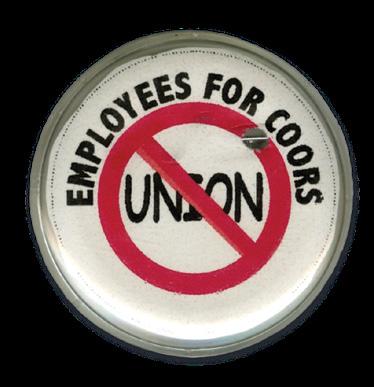
The term scab is a derogatory name for union members who refuse to strike or workers who are hired to replace striking employees.
Vern Wagner, during the 1977 strike, when they weren’t on the picket line strikers hung out at the Ace Hi Tavern on Washington Avenue. Owners Leo and Sid Stillman turned off the Coors neon signs in support of the cause. Unofficial historian Rick Paine adds, “The Ace Hi was a local hangout for brewery workers, especially folks coming off graveyard. It was one of the main reasons they opened early. When you work ‘gravy,’ 7–-8:00 o’clock in the morning is prime beer-drinking-withyour-buddies time. Al Babb Sr. was vice president of operations and the plant manager. He walked into the Ace Hi one time during the strike and addressed the men. His words were simple: ‘As you sit here drinking your Budweisers and badmouthing the Coors family and company, tell me how that helps get your jobs back.’ ”
Most modern accounts state that the Coors family insisted on polygraph or “lie detector” tests for applicants because they were extra cautious after the 1960 kidnapping and murder of Adolph Coors III. Paine quotes Bill Coors as saying that they started even sooner to help with grievance arbitration. Coors said that the company had to fire a driver for dishonesty when Coors lawyer Bud Lerton caught him lying, and the need for polygraphs “stuck.” The employee countered that the union had told him and others exactly what to say under oath. “Well if that’s the way it is,” Bill Coors said, “we have to protect our people from…perjuring themselves. So that is when the polygraph came into being, and it was written into the union contract.”
With the 1977 strike, the questions deemed most offensive were removed; polygraph screening was eliminated in 1986.
DISCOVER I GoldenHistory.org 7
Last union hall for Brewery Workers Local 366, once located at 4510 Indiana Street in Golden, Colorado, around 1969. Courtesy Jefferson County Assessor’s Office.
Meanwhile, no other Denver metro production or manufacturing jobs could touch the wages you could earn at Coors. Coors jobs were prized, and the brewery’s workforce expanded beyond Golden into the surrounding communities of Arvada, Wheat Ridge, and Westminster. But hard feelings from the strike lingered for years, sometimes within families that had seen one brother on the picket line and another refusing to walk out.
April 7, 1977 – History repeated itself when 1,472 members of Coors Brewery Workers Local 366 struck over working conditions, seniority, salary, and the demand to end polygraph tests—a practice the company had initiated after the 1957 strike. The union vote to strike was not unanimous, and within the first month of those who walked out returned to their jobs. The company replaced the holdouts via in-company transfers and non-union replacements. Without unanimous support, the strike lost momentum, and, in December 1978, brewery workers voted to decertify the union altogether. Local 366 had no choice but to dissolve.

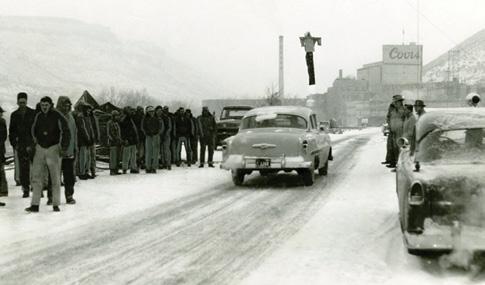
Lifelong Golden resident Ed Hartl was both a longtime Coors employee and Local 366 department representative who also sat on the union’s executive board. Ed stood behind the union even while many of his coworkers would not. After the strike, he never went back to Coors. In a recent interview, he summed up the experience: “We were a
many willingly returned to work, he added, “They were scared to be without paychecks.”
A nationwide boycott ensues
When the 1977 strike failed, the national AFL-CIO hired former Golden resident, Coors employee, and Local 366 organizer David Sickler to initiate a nationwide boycott of Coors modeled after the grape and lettuce boycotts in California and building on local boycotts by Chicano activists and others. In an effort that would ultimately last
in support of the Golden strike.
To quote Bill Coors in 1997, “Nobody ever really wins a strike, but the company ultimately prevailed. Coors is still ‘unionfree.’” He went on to clarify, “we are not ‘non-union,’ nor ‘anti-union.’ We are just union-free.” And while employees have made efforts to unionize in years since, those efforts have been largely ignored by the majority of their coworkers. The Bill Coors mantra that he preached at brewery management meetings and which fueled the Coors response towards unions for years, sums up the Coors family’s philosophy perfectly, “If we treat our employees right, they don’t need a union.”
This is a complicated story with multiple viewpoints. We’re committed to sharing them all. If you lived this history and want to join the conversation, or contribute related artifacts or photos, please contact Mark Dodge at: MDodge@GoldenHistory.org

Strikers with effigy at the 12th Street entrance to Coors Brewing Company.

8 DISCOVER I SPRING 2021
Photo © Golden History Museum & Park, City of Golden Collection.
The Daily Transcript, Thursday, April 7, 1977.
Adolph Coors Company

Brewery
Strike of 1977:
My

early years as a “scab” at the brewery
By Herschel Brown
On April 5, 1977, Brewery Workers

Local 366 called a wildcat strike at the Adolph Coors Company in Golden, Colorado. I had just moved to Golden in June 1976 working as an appliance repairman. I had no idea when the news of the strike hit the newspapers and network TV it was going to be one of the biggest game changers of my entire life.
After several weeks of trying to convince striking employees to come back to work Coors announced they would start hiring replacements. I was encouraged by several people to go apply. After all these brewery workers were in the top 5% income earners in the country. I seriously did not think I had even a remote chance of getting hired. On April 21, 1977, I decided to go and apply. I would probably would have hated myself if I hadn’t at least tried.
On the morning of the 22nd I arrived at the employment center on Ford St. in Golden. The crowd was unbelievable. Entering the front door I found what looked like hundreds of people inside filling out applications or trying to get one. I made my
way to the application table. There were people filling out applications, at tables, writing against the wall, standing with clipboards. All these people writing and other job seekers walking around bumping into them. At this point I was convinced this may be a complete waste of my time.
After filling out the application I found the end of the line going to the “Bring completed application here” table. There were five or six people seated behind the table quickly glancing over each application. The normal reply to the applicant was “OK thanks, we’ll call you if we need you.” When I finally got my turn at the table, the man looking over my application seemed to take forever. Finally he said, please come around the table and go with this lady. He handed my application to the woman and to the back of the building we went.
In the rear we settled into a room with another person to go over my application line by line. They were very precise on everything on every line. I believe my time going to trade school for refrigeration servicing was my ticket around the table to the interview. They informed me to report the next morning for a physical and polygraph.
I reported the morning of the 23rd. First
about stealing from employers and honestytype questions. Next was the physical. After I was given a go on the physical and polygraph they told me to report to the main lobby on the 24th at I think around 7 pm for my assignment.
The main lobby of the brewery was not nearly as crowded as the employment center. There were department supervisors and leadmen standing around talking. Pretty soon a man with a clipboard came into the room and started calling names. The supervisors and leadmen were standing in close proximity to the name caller. The person’s name called would go up front and center. Management people would look them over. This I think was to size the worker up physically for the job at hand. They didn’t want a 120-pound person lifting or pulling on a 50- to 60-pound object for 8 hours. They finally called my name, looked me over, then simultaneous nods of agreement, and then informed me I would be going to the brewhouse. The leadman walked me over to join his group. When done there were 8 or 10 groups waiting to go to their assigned departments.
DISCOVER I GoldenHistory.org 9
(Written January 2021 at the request of GHM Curator Mark Dodge)
Continued overleaf
Herschel Brown in 1986.
Photo © Golden History Museum & Park, City of Golden Collection.
Our group was taken to a lunchroom near the brewhouse. There it was explained that we would be taking a short tour, issued equipment (coveralls, boots etc.) and start training. The main thing they emphasized was the people on the floor working were either management or returning union workers that had given up on the strike and crossed the picket line to come back to work. These workers were not very happy about training people to take their buddies’ jobs. We were to keep conversations short and only ask questions about our task at hand. The company was very worried about
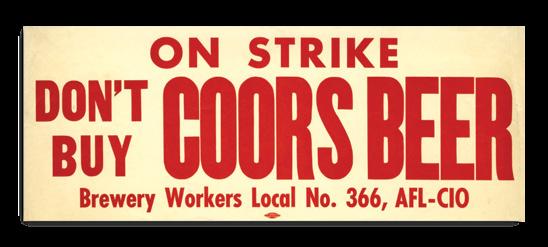
trouble breaking out inside the brewery. The company’s concerns were well founded. There was no doubt these union people did not want us there and took it personally. The air was so thick you could cut it with a knife. A few times the newbies were deliberately told to do something wrong so they would look bad or deficient. The first few weeks on the job resulted in tempers flaring, workers getting physical and a couple firings.
The company gave everyone name tags trying to familiarize workers with the people they were working with. Many of the union
workers didn’t much care about your name. Quite often instead of calling you by name the norm was “Hey scab, do this” or “Hey scab, it’s supposed to be this way.” Sarcasm was not in short supply. I think calling us “scabs” made them feel better. In reality they knew once they left the picket line they themselves were also scabs and having a hard time dealing with it. After several months it was almost like no one had a first name. The new employees started calling the union people scabs and for some reason it lightened the tension immensely. After a while when calling someone a scab just got you a smile.


Going to work for the first few years certainly had its challenges. For the first year all entrances to the brewery property were heavily covered by union picketers. My first few months were particularly stressful. My wife and I both worked but had only one car. The first few days on day-shift she would take me to work. Driving through the picket line was terrifying for anyone. I would drive in but she had to drive out. The picketers could probably see the fear in her face as she drove through and gave her a little extra harassment. It was not uncommon for picketers to walk in front of your vehicle to make the driver slow down or come to a complete stop. They would be yelling (sometimes obscenities) and pounding on the top and sides of the vehicle. It was not something a person would get used to. I knew it was probably one of the most dreaded things in her life and borderline unbearable. After a few days of this I decided to avoid the pain for her. She would drop me off on Ford St. in front of Safeway and I would walk through the picket line. Unless you have done this, you can’t imagine how unnerving this is. Prior to my decision to do this there had been fights between workers and picketers. The picketers had kicked the doors in on passing vehicles. I knew walking through the picket line would

10 DISCOVER I SPRING 2021
During the Brewery Workers Local No. 366 strike of Coors Brewing Company in 1957, boycott posters like this were used to urge union members and the public to boycott Coors products.
Photo © Golden History Museum & Park, City of Golden Collection.
Coors Brewery still dominates the Golden skyline and influences the Golden community after 150 years.
Photo © Golden History Museum & Park, City of Golden Collection.
be a picketer’s dream come true, and it was. The first few walks through even had me questioning my sanity. Walking through was not uneventful. They started yelling and screaming as soon as they saw me walking in their direction. Stepping in front of me to slow me down, getting in my face screaming obscenities, putting their hands on me and poking me with their sign-sticks on occasions. It was never to a degree to cause any injuries.
After a few months we were able to purchase a second vehicle. The picketers seemed to have periods when they elevated the harassment. It seemed to follow news

about more union workers returning to work. This had to be a hit for their cause. The workers crossing the picket line were subjected to picketers kicking car doors in, broken glass, slashed tires and nails and sharp objects in the roads leading to plant entrances. This went on for several years.

After a couple years the workers in the brewery managed to jell together and there were very few problems. The thing that had not gone away in my 29 years was the older union workers who still referred to the 1977 hired help as scabs. It was by this time brewery lingo and not meant as an insult and almost always got a laugh.
My employment at the Coors Brewery set my life in a direction that had almost always been positive. I have always been proud to be a Coors employee and now a retiree. Working and participating in the expansion during this time period was fun
and an honor. I would do it all over again. The early years after the 1977 strike is a time hard to capture in words. These years were very emotional and hard for everyone involved. These were very difficult times for the company and the employees. Every worker had different experiences and handled them in as many different ways as there are people involved. Adolph Coors Company was a great American company trying to run their company in a very competitive market and difficult time.
I will always believe the company wanted to do what was right for all their employees. The striking employees were good decent people trying to support their families. Last but not least the 1977 scabs were also good people chasing their dreams. In the end, for decades these two groups of employees jelled and made a very unique and efficient workforce.
DISCOVER I GoldenHistory.org 11
Union men and families heckle non-strikers leaving Coors Brewery at end of work shift, August 6, 1957.
Photo © Golden History Museum & Park, City of Golden Collection.
Programs
These programs are subject to change and may potentially have in-person viewing options (to be announced). Masks will be required for all in-person events. Go to GoldenHistory.org/events for the most up-to-date details. Programs are free for members and $10 for non-members (plus eventbrite fee).
May 19, 2021, 6 – 7:30 pm Colorado Water and the American West
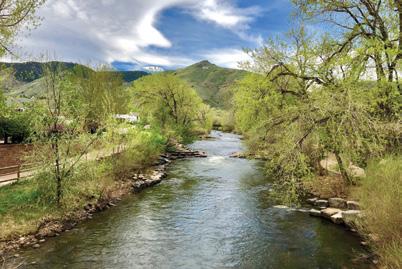
Please join us for a discussion dedicated to Colorado’s most precious resource: water. Matthew S. Makley, Professor of History at MSU Denver, will offer a lecture and conversation about the history of water in Colorado and the American West. This sweeping exploration begins with a look at how First Peoples used water on the Colorado Plateau and concludes with a brief examination of how Denver has developed its water infrastructure.
June 14, 2021, 6 – 7:30 pm

Excess to Extremism: How Colorado’s National Guard Spoiled Denver’s Kitchens 1903-1917
In the wake of violent labor disputes in Colorado’s two-year Coalfield War (1903-4) and a final climactic attack on miners and their families at Ludlow (1914), actions by Colorado’s national guard led to a domestic rebellion in the homes of Denver’s elitist Capitol Hill women. Join author and presenter Jane Little Botkin to uncover the hidden stories behind the domestic rebellion.
July 22, 2021, 6 – 7:30 pm
Buffalo Bill: How his Tumultuous Past turned into Box-office Gold
Buffalo Bill Cody has gone down in history as one of the greatest showmen who ever lived. However, before Cody was famous (and even afterwards), he had a few of his own demons to put to rest. Led by returning presenter and historian Randi SamuelsonBrown, this talk will focus on Cody’s earlier years as the west opened, his enduring support of social justice and his later years when a rather tumultuous past turned into box-office gold.

August 18, 2021, 6 – 7:30 pm
The Coors Beer Boycott: How a Hometown Industry Met Modern Activism
The Coors family ran their business according to Joe Coors’ beliefs about what his workforce should be and how they should behave. He was antiunion, pro-white male labor and was unbending in his desire to control his workers. In the 1960s this began to bump up against civil rights movements, causing increasing tension that led to a multidecade boycott of Coors products. Come hear Dr. Rebecca Hunt tell the story of this challenging era in the history of brewing.
12 DISCOVER I SPRING 2021
Photos © Golden History Museum & Park, City of Golden Collection unless otherwise noted.
Photo © Justin LeVett Photography
September 16, 2021, 6 – 7:30 pm


Colorado School of Mines, The Early Years

The Colorado School of Mines has been part of the fabric of Golden since its earliest days, becoming a territorial institution in 1874 and a Colorado State institution when in 1876. Join presenter Lee Katherine Goldstein to learn about the early days of this historic institute of higher learning.

October 2, 2021
Golden Cemetery Tour
Visit the graves of legendary Golden characters and hear tales about their lives from famous storyteller Dennis Potter, Museum volunteer since 2008 and retired Jefferson County Sheriff’s Department Captain.
Multiple time slots are listed on the website. Tours begin and end at the Golden Cemetery. This program sells out every year, so get your tickets early. This is a rain-or-shine event; weather will not force a cancellation.

November 11, 2021, 6 – 7:30 pm
Seesaw:

How November ’42 Shaped the Future
By late 1942 the world had been fighting for years, with no end in sight. The five weeks from late October to early December saw campaigns, battles and developments which decisively turned the war to the Allies’ favor. Author and returning presenter Stan Moore takes a fresh look at the personalities and events that led up to this critical period. He also examines five campaigns around the world in the month of November.
DISCOVER I GoldenHistory.org 13
Copy of c. 1873 lithograph of the original Colorado School of Mines campus.
Transfer decal of Colorado School of Mines burro mascot Blaster, 1952.
A legendary person who called Golden home
Golden History Museum & Park is committed to celebrating the lives of “the good people of Golden,” past and present, as exemplified in the Legendary People gallery.
Vine Deloria Jr. and his family moved to Golden in 1972, living there until he accepted a faculty position in the Political Science Department at the University of Arizona in l978. He and his wife returned to the same neighborhood in 1993 when he was teaching at the University of Colorado. He was able to do most of his writing while living in the area because for him it was a special place that energized and inspired him.
The following is extracted from his New York Times obituary on Nov. 15, 2005.
Vine Deloria Jr., a Standing Rock Sioux who burst into the American consciousness in 1969 with his book “Custer Died for Your Sins” and later amplified his message through 20 more books about the Native American experience, died on Sunday, a family friend said.


He was 72 and lived in Golden, just west of Denver.
Mr. Deloria, who was trained as both a seminarian and a lawyer, steadfastly worked to demythologize how white Americans thought of American Indians. The myths,
14 DISCOVER I SPRING 2021
he often said - whether as romantic symbols of life in harmony with nature or as political bludgeons in fostering guilt - were both shallow. The truth, he said, was a mix, and only in understanding that mix, he argued, could either side ever fully heal.
And while his Custer book, with its incendiary title, was categorized at the time as an angry young man’s anthem, Mr. Deloria’s real weapon, critics and admirers said, was his scathing, sardonic humor, which he was able to use on both sides of the Indian-white divide. He once called the Battle of the Little Bighorn, where Lt. Col. George Armstrong Custer and the Seventh Cavalry were defeated by a combined force of Sioux and Northern Cheyenne in 1876 in the Montana territory, “a sensitivitytraining session.”
“We have brought the white man a long way in 500 years,” he wrote in an OpEd article in The New York Times in 1976. “From a childish search for mythical cities
of gold and fountains of youth to the simple recognition that lands are essential for human existence.”


In “We Talk, You Listen: New Tribes, New Turf” (1970), Mr. Deloria argued that technology and corporate values were destroying American life, and urged a return to the tribal standards of Indian culture as a window to salvation.

In “God is Red” (1973), he took that position of deliverance-through-Indianways further, arguing that American Indian spiritual traditions, far from being dated, were in fact more in tune with the needs of the modern world than Christianity, which Mr. Deloria said fostered imperialism and disregard for the planet’s ecology.
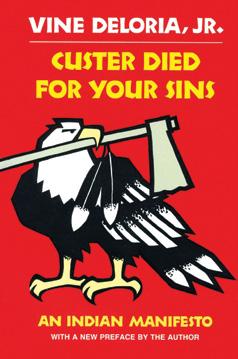
But Mr. Deloria often said he was writing for Indian audiences most of all, hoping, he said, to instill belief in a culture had been shattered by history, and by deliberate government policy.
Vine Deloria Jr. was born on March 26, 1933, in one of the poorest parts of the nation, then and now, in Martin, S.D., near the Pine Ridge Oglala Sioux Indian Reservation, the son of a Indian Episcopalian clergyman. He was educated initially in reservation schools, and after a stint in the Marines in the 1950’s, received a degree in general science from Iowa State University.
But religion and spirituality at the border
of Indian and white ways was a running theme in the Deloria family - an ancestor was reportedly one of the earliest Sioux converts to Christianity, in the 1860’s - and Mr. Deloria eventually followed his father’s path and received a master’s degree in theology in 1963 from the Lutheran School of Theology in Illinois.
From there, from 1964 to 1967, he worked for the National Conference of American Indians, where, even before the book that made him famous, he became a leading spokesman for Indians in Washington. He often testified before Congress at a time when the ferment of ideas and social movements in civil rights and ethnic identity were in full boil. He took a law degree at the University of Colorado in 1970, and later, in 1990, joined its faculty, teaching history until his retirement in 2000.
Mr. Deloria’s other books included “Behind the Trail of Broken Treaties” (1974) and “The Metaphysics of Modern Existence” (1979).
Do you know a legendary person we should feature? Write to MDodge@GoldenHistory.org.

DISCOVER I GoldenHistory.org 15
Vine Deloria Jr. (left) and friend Robert Thomas pose under Golden’s Welcome Arch in 1976.
Photos © Golden History Museum & Park, City of Golden Collection
Vine Deloria Jr. at Golden’s Table Mountain Inn after a book signing and lecture in November 1999
Photos © Golden History Museum & Park, City of Golden Collection
Race-based restrictions
and mapping
By Christopher J.J. Thiry
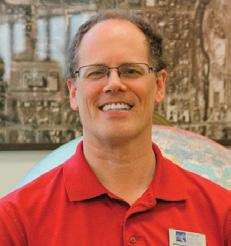
While today, many of us are familiar with real estate covenants that limit what color you can paint your house, before 1948 such covenants could legally limit residence by race. In an effort to keep areas racially segregated, starting in the 1910s, people used real estate “restrictive covenants” to limit the ownership or occupancy of properties. The covenants were found nationwide and were legally binding. Jefferson County and Golden were not immune to these efforts segregate fellow citizens.
Staring in the spring of 2020, and working with the Jefferson County Archivist, I identified 173 plat maps of subdivisions created between 1917 and 1950 that contained language noting the properties may be owned or occupied only by people of the “Caucasians race” or may not be owned or occupied by people of the “Mongolian or Negro race.” The neighborhoods with such restrictions were not limited to one part of Jefferson County; in fact, several subdivisions built at the time were in or directly adjacent to the city of Golden.

I examined over 1,000 plat maps of new subdivisions or neighborhoods in Jefferson County dating from the 1860s to 1950; I found over 200 maps with restrictive covenants, with approximately 85% containing language restricting residence or ownership of the properties by race. The first known incidence of race-based housing restrictions being placed in a covenant
in Jefferson County occurred in a new subdivision in the town of Evergreen in 1917. Starting in the mid-1940s, almost all new plat maps contained this language.
The U.S. Supreme Court struck down race-based restrictions in covenants in May 1948 in Shelley v. Kraemer. Oddly, the racebased exclusionary language continued to be found on maps filed in Jefferson County until February 1950. To this day, the offensive language remains on the official documents housed in the Jeffco Clerk & Recorder’s Office; however, it is important to note that the language is unenforceable and each of these documents is stamped with text explicitly saying as much.
The concentration of the subdivisions in Jeffco with race-based restrictive covenants were centered upon Evergreen, Indian Hills, and 10 blocks of either side of Colfax or Wadsworth Avenues. There were not many large areas in Golden to be subdivided, because most of the property was already broken into house-sized parcels. However, I found one new subdivision within the city limits, and two adjacent to the city had racebased restrictive covenants. The “Sunshine Park Subdivision,” centered around Sunshine Parkway and High Parkway, was entered into the County records in the spring of 1944. In its dedication, it says “Ownership in this subdivision shall be restricted to members of the Caucasian race.” The same language is used in two subdivisions next to Golden: Schreiner’s Resubdivision, on the southeast corner of 44th Avenue and McIntyre Street,
16 DISCOVER I SPRING 2021
Christopher J.J. Thiry has been a Golden resident and the Map & GIS Librarian at the Colorado School of Mines for the last 25 years. He can be reached at cthiry@mines.edu.
and Happy Valley Acres on the north side of South Golden Road at Orion Street.
Using digital copies of the plat maps of Jefferson County that contained restrictive covenants, I identified the areas they covered and extracted some language and other facts. I mapped all the subdivisions using a geographic information system (GIS). After attaching some of the ancillary information, I created a website (https:// libguides.mines.edu/jeffco) showing the location of neighborhoods with restrictive covenants. The website also contains information about the project, along with a list of resources, readings, and videos.
My project is on-going and you can help as we discover and document our past. There are many missing pieces to the story. Most importantly, I have found very few personal accounts regarding race and housing in Jefferson County. The plat maps and associated documents


present dry facts, but how did these restrictions affect individuals and families? Additional questions on the topic of the history of racism in housing developments and its legacy in Jefferson County and Golden include: were the developers and county officials merely copying existing racist language, or was the insertion of the language purposeful? How did the policies from the 1910s to 1950 impact the occupancy of real estate in the county and the current demographic makeup of Golden and Jefferson County?
I must emphasize that these plat maps that contain race-based restrictions were signed by government officials including those from the County Planning Board, County Clerk & Recorder, and County Board of Commissioners; these officials represented the will of the people of the County at the time. The covenants were legal documents backed by law and policing.
While some residents remained clueless regarding the existence of the racism on their real estate documents, other residents welcomed and supported race-based segregation in housing.
Sadly, systemic racism was not limited to one part of our country. These covenants with race-based exclusionary language existed and were enacted here in Golden and Jefferson County, Colorado. This project can help inform our community so that we no longer remain naïve nor willfully ignorant of how our county came to be in its present form. My fondest hope is that the knowledge generated from this project can be used to make this a more perfect union with liberty and justice for all.

“My project is on-going and you can help.”
https://libguides.mines.edu/jeffco
DISCOVER I GoldenHistory.org 17
Staff Profile Annika Firn

Volunteer Profile Pat Donahue
I
was born in Tacoma, Washington, but raised outside of London, England, where I spent my formative years surrounded by historic buildings and landscapes. My parents consistently emphasized the value of travel, reading and culture which had a subtle yet effective influence on my lifelong interests. The additional fact that all of my favorite teachers growing up taught history, led me to study History and Anthropology at Colorado State University, followed by a master’s degree in Museum Studies from the University of Glasgow in Scotland.
Before my master’s program, I returned to Seattle for a year where I interned and worked at the Seattle Art Museum and the Wing Luke Museum of the Asian Pacific American Experience. The Wing in particular showed me the power of community connection and empowerment. This is also where I first experienced working with school-age children. I originally bought into my introversion and wanted to spend my career with artifacts and archives (less people) but after my graduate degree in Scotland, I realized that maybe I was more
of a people person than I thought.
I made my way back to Denver where I led school programs at History Colorado, the Children’s Museum of Denver at Marsico Campus and Golden History Museum & Park. These kids took me down an entirely different path towards museum education. Physically seeing the connections and wonder on their faces as they learned about their home state was incredibly powerful. I’ve now been with GHM&P for five years, three of which have been spent in my current, full-time position in charge of student and family programs.
My initial introduction to Colorado was a family ski trip to Breckenridge during which I quickly fell in love with the Rocky Mountains. We spent many summers with family in Washington but never spent much time in the northwest mountain ranges. However, as my Dad says, I’m a full Colorado girl now: camping, hiking, climbing 14ers, and skiing. When I’m not in the mountains, I love to start my days at the gym, check on my houseplants, discover a new patio with friends, or love on friends’ (and sometimes strangers’) dogs.
Born and raised in the rubber capital of the world, also known as Akron, Ohio, Pat Donahue knew from an early age that she wanted to help people. To do so, she pursued a career in nursing and graduated from the University of Akron in 1982. After working at the Akron General Hospital for a few years, she wanted a change and took a job as a traveling nurse. Upon adventuring throughout the U.S., Pat fell in love with Colorado and decided to settle in the Golden area around 1991. While working as an Intensive Care Unit nurse at Porter Adventist Hospital, Pat met a quiet and confident Cardiac Care Unit nurse named Kevin. Sharing their love of giving back to their community and exploring the great outdoors, Pat and Kevin have been happily married since August 1997.
In 1994, both Pat and Kevin knew that they could do more to help others. Together, they moved to Minnesota so Kevin could pursue training in anesthesiology while Pat decided to switch things up (again) and began attending law school. After graduating with honors from the William Mitchell College of Law in 1997, Pat and Kevin moved back to Colorado and created their forever home.
For several years, Pat worked at a criminal defense and civil litigation law firm as a family law attorney in downtown Denver. Later, Pat opened and still runs her own mediation office, PJD Mediation, LLC, and strives to “improve relationships, one

mediation at a time.”
In her free time, Pat continues her passion for helping others through volunteerism. Along with volunteering at CASA (Court Appointed Special Advocates) in Jefferson and Gilpin Counties mentoring children in foster care, Pat also began giving her time to Golden History Museum & Park as a chicken caretaker and beekeeper since the summer of 2017. When asked about her reasons for volunteering with the Museum, Pat said she “always wanted to learn more about chicken and bee caretaking but really wanted to be more connected with the Golden community.” She loves walking the path along Clear Creek with her husband, Kevin, and their two dogs, Aly and Tiberius.
Pat is a huge help to the Museum. In addition to her regular caretaking duties, Pat takes initiative and fixes numerous maintenance issues such as rat and wasp extermination, roost improvements, coop and yard enhancements, and even replaced part of the chicken yard fence with the help of her husband. Additionally, Pat singlehandedly worked to establish the current hives at the Golden History Park and manages the over 150,000 resident bees. Literally, no job is too big or too small for Pat and all of those around her feel her enthusiasm and positivity. Pat continues to be an incredible caretaker to our chickens and bees, as well as an amazing friend to GHM&P staff and her fellow volunteers.
18 DISCOVER I SPRING 2021
Golden History Museum & Park
Donors January — December, 2020
$10,000+
Linda and Dale Baker City of Golden Scientific and Cultural Facilities District Pat Spieles
$1,000 — $9,999
Downtown Development Authority Mark and Nancy Foster
Golden Civic Foundation Cathy Lytle
Kristi and Robert Mallow McKee Family Foundation John and Andi Pearson Danielle and Louis Samuel
$500 — $999
Jennie and Charles Boeder The Denver Foundation, Greenwood Fund Wendy and Rick Goad Justin LeVett Photography
$100 — $499
Lydia Andrews-Jones and Jason Matisheck
Darryl Annett
James and Joy Bauman
Richard and Cynthia Bauman
Lark Birdsong and Julie Brisson
Bill and Carol Bleau
Shelly and Nick Bleckley
Betty Bloom
Patrick and Melissa Bojan
Kristie Brice and Mike Schwartz
Cannonball Creek Antiques & Appraisals

Traci L. Case and Peter Gotseff
Jim and LouAnne Dale
Ingrid Depta
Pat Donahue and Kevin Skeate
Dressel-Martin MediaWorks, Inc.


Ewers Architecture
Margaret and Vincent Faso
Sheryl and Steve Fassino
Kristine and Kevin Fletcher
Elaine and Joseph Marolla
Renaye Murphy
Dixie Termin and Ron Miller
Richard Flint
Larry and Barbara Foos
William and Frances Fraser
Norma Fricke
Betty and Thomas Gleaton
Lynne Haigh
Kathleen Weller Horky and Kevin Horky
Steve Hughes
Janet Johnson
Paul and Karen Jones
Diane and Marv Kay
Sharon and Robert Kirts
Sarah and Todd Labosky
Mary Anna and Walter Madden
Pat and Judy Madison
Bill and Suzy McKee
Helen McVey
George Meyers and Merrill Wilson
Carl and Anne Mulay
Bob and Joyce Nelson
Mark and Cathy Pattridge
Gerchard Pfau
Hayley Schneider
Kermit Shields
David C. Shuey
Jack and Catherine Skokan
James and Melanie Smith
Sherry and Roger Stuart
Jean Theobald
Justin and Sarah Wade
Larry and Betty Weaver
Laura and Michael Weinberg
Angela and Tom Wheaton
Jeanne Whittaker
Mike and Mary Wood
Alan and Elizabeth Woodard
John P. Young
Frank Young and Terre Deegan-Young
Collection Corner
New acquisitions
Founded in 1910 as the Golden Building and Loan Association, this institution celebrated 50 years of service in March 1960. The bank moved to 701 13th Street in Golden in 1957. c. 1960s.
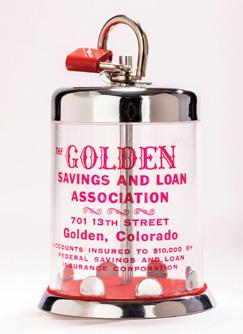
Untitled watercolor by Otto Kuhler, c. 1950.

DISCOVER I GoldenHistory.org 19
Photos © Justin LeVett Photography
Collection Corner
By Mark Dodge, Curator

Much of our work at Golden History Museum & Park occurs behind the scenes. Honoring our commitment to the care and preservation of thousands of artifacts entrusted to us, the museum actively completes at least one major conservation project annually. Past projects include the 1878 Jefferson County jail register, 1876 Koenig 38-star American flag, 1959 Golden Centennial banner, and 1859 Clarke map.
Last year we identified two unique and historic clocks for cleaning and repair: one from the late Woods Mortuary which closed in 2017, and another which originally hung in Tierney Jewelry (and later Plummer’s Jewelry) of Golden. GHM&P applied for and
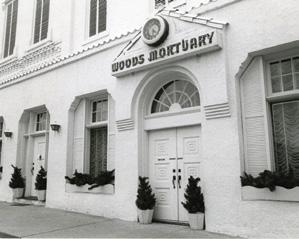

was awarded a conservation grant from the Greenwood Fund of the Denver Foundation to support this crucial work.
We seek out the best and most qualified experts for conservation work. Before committing to any conservation a thorough treatment proposal is required which outlines the scope of work to be completed. For this delicate work we decided to work with Mike Korn of The Clock Fixer. Mike had this to say about our Woods Mortuary grandfather clock.
Even though it is still ticking, I believe the movement will need to be cleaned and checked for general wear. The clock is over 40 years old and will show some normal wear & tear. While the unit is apart, the wheel pivots will be checked and polished where needed. The pivot holes will be
checked for wear and rebuilt where needed. After repair, the clock will be ultrasonically cleaned in hi-grade cleaning solution. Then it will be assembled, oiled, and tested. This process will need to be done at my shop. I will need to remove the movement, pendulum, and three weights.
Work is finished on the 1973 grandfather clock that once kept the time in the lobby at Woods Mortuary. Get a good look at the dismantling process from the short video on our blog (GoldenHistory.org/blog) and see some of the detailed inner workings in a photo gallery at the bottom of the page. See it in person at the museum where it is on display for the remainder of the year.
Up next: the c. 1880s Seth Thomas calendar clock from Tierney’s.
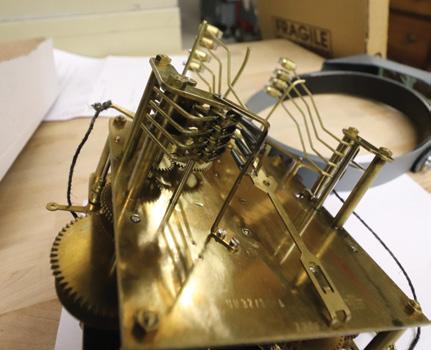
20 DISCOVER I SPRING 2021
They take a licking and keep on ticking, but still need a little TLC
Jolly Rancher treasure trove finds permanent museum home
 By Mark Dodge, Curator
By Mark Dodge, Curator
Happy farmers, jolly ranchers and candy cowboys gather ‘round because a premiere Jolly Rancher collection is coming to Golden History Museum & Park. After years of working with members of the Harmsen family, John Harmsen, the grandson to founders Bill and Dorothy Harmsen, decided we’re the best place to preserve this sweet slice of Colorado history. When completed in 2021, the generous donation will represent the finest public collection of Jolly Rancher history anywhere.
Jolly Rancher is one of Golden’s most recognized exports behind Coors beer and countless highly educated mining engineers. It grew to national fame as the candy from Colorado. From a humble beginning on Washington Avenue dishing soft serve ice cream in a rented storefront, the Harmsens quickly pivoted to crafting quality chocolates before hitting a winner with a cinnamon hard candy forever known to history as Fire Stix.
Over a year ago I approached John to discuss the sizable collection he inherited from his father, and onetime Jolly Rancher President Bob Harmsen. Bob was passionate about his family’s history and their candy legacy. As a result he amassed a sizable collection, some of which he loaned to Golden History Museum over the years. Safely stored were early documents from the founding and several buy outs. The Ward Road plant (that’s right—in Wheat Ridge, not Golden) was closed and finally demolished in 2005.
A major donation like this requires a work plan. I’ve spent a couple of days with John over the past few months sorting and sifting through countless items and boxes
scattered across different rooms on two levels of the family offices. We’ve been assessing value and quality, looking for the best items to tell the story. Our work isn’t done. In September I retrieved nine different company films and interviews from John’s basement and sent them out to be digitized. Have a listen to a four-and-a-half-minute profile of William (Bill) Harmsen by Bob Lilly of KOA Denver, recorded July 10, 1957, and stored in our online collection.
Other highlights include:
Product packaging and design (including original works by industrial designer Otto Kuhler and Bob Cormack)
Chocolate candy molds
Signage and advertising
Various media (including original photographs, films, and interviews)
Memorabilia like belt buckles and hat pins

Custom sports sponsorship materials (In the 1980s the company sponsored a rodeo team; John donated a custom team jacket, chaps, and team photo.)

Corporate archives on the early franchising efforts and more

The donation will be known as the Harmsen Family Collection. While work continues on our multiyear Legacy Collection Inventory Project, we’re committing time to processing this important new collection to add to our publicly available online resources.
If you have a Jolly Rancher memory to share or are hanging onto something that belongs in the museum, I’d love to talk. Contact me at 303-277-8714 or MDodge@GoldenHistory.org.
DISCOVER I GoldenHistory.org 21
Photos © Justin LeVett Photography


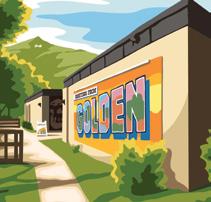
Membership Be a part of Golden history. Become a member today! Join or Renew Today Call, mail, or stop in. 923 10th St., Golden, Colorado 80401 l 303.278.3557 GoldenHistory.org/member Thank you for supporting Golden History Museum & Park I NDIVIDUAL ($40) DUAL ($60) HOUSEHOLD ($75) PATRON ($125) BENEFACTOR ($250) FOUNDER ($500) DIRECTOR’S CIRCLE ($1,000+) YES, I want to support Golden History. DISCOVER I GoldenHistory.org 23 Free admission for cardholder to almost all programs Exclusive members’ only access to recorded programs 10% merchandise discount Special pricing on premium programs and events Insider’s Discovery events, other special programs Hands-on History camp discount Exclusive early registration for Hands-on History Guest passes to almost all programs when accompanied 2 3 4 4 4 by member Recognition on website and donor wall Reciprocal admission and benefits at over 1,000 museums Lunch with the Director INDIVIDUAL ($40) DUAL ($60) HOUSEHOLD ($75) PATRON ($125) BENEFACTOR ($250) FOUNDER ($500) DIRECTOR’S CIRCLE ($1,000+) Director’s Circle ($1,000) Founder ($500) Benefactor ($250) Patron ($125) Household ($75) Dual ($60) Individual ($40) Seniors (65+) may deduct 10%. Please accept my extra, tax-deductible donation of $25 $50 $100 $ (other) Total enclosed $ Name Address City, state, zip Credit card # Exp. date Signature Phone Email (opt-in for e-newsletter, opt out anytime)
Art Exhibits
Golden History Museum & Park has a rich collection of historic and contemporary artwork by artists who lived in, worked in, or visited the area. The Salon—so named for its ceiling-to-floor salon-style installation of work— continuously exhibits pieces from the permanent collection as well as changing exhibits by local artists who draw their inspiration from the local surroundings. On view in 2021:

Mitchell Dill
July 1 - October 10, 2021
Melinda Laz
Oct 16, 2021 - February 6, 2022

923 10th St., Golden, Colorado 80401
Image by Mitchell Dill












 By Mark Dodge, Curator
By Mark Dodge, Curator


 By Mark Dodge, Curator
By Mark Dodge, Curator


































 By Mark Dodge, Curator
By Mark Dodge, Curator






